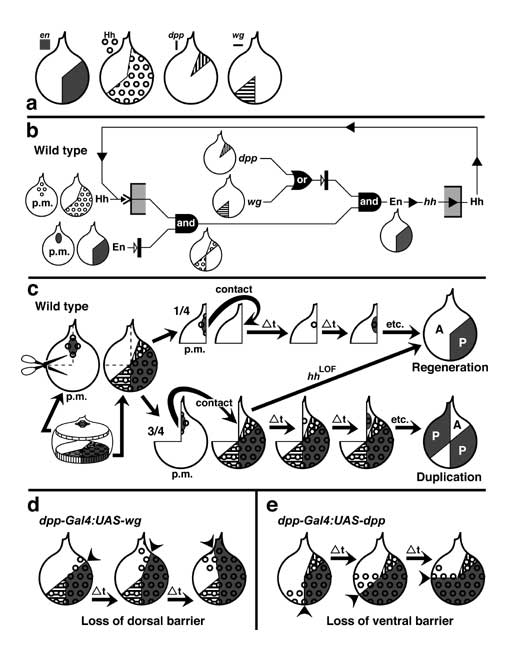Select image to enlarge

Figure 5.10
Hh-En-Hh feedback loop and how it solved the Quadrant Regeneration Mystery.
a. Regions where key genes are transcribed (en, engrailed; dpp, decapentaplegic; wg, wingless) or protein (Hh, Hedgehog) is detected. Symbols (shading or hatching) are below names.
b. Hh-En-Hh loop (cf. Fig. 2.7 for icons). The logic begins at left with 4 maps of a 1st leg disc: upper vs. lower are Hh vs. En; left vs. right are peripodial membrane (p.m.) vs. columnar epithelium (c.e.). In the p.m. of 1st-leg discs, en and hh are transcribed in a dorsal spot [1472]. In the c.e. (of all leg discs) en and hh are expressed in the P compartment, and Hh diffuses into two sectors (map below first 'and') where en-OFF (A-type) cells can 'hear' it (P cells are 'deaf'). In theory, these cells should respond by turning on en (i.e., switch to en-ON) because a Hh —> en link emerges in late 3rd instar (cf. Fig. 6.4) [1472, 4136], and indeed a sliver of cells within these sectors does so (not shown) [350]. However, remaining cells in the border zone cannot because (1) Hh causes them to express Dpp or Wg (cf. Fig. 5.9b), and (2) Dpp or Wg blocks this Hh —> en step. Thus, the En map (below second 'and') does not change perceptibly. In this steady state (remainder of the loop) En continues to activate hh, and Hh continues to diffuse out of the P compartment.
c. As shown in the side-view schematic (lower left), the leg disc is a flat sac (cf. Fig. 5.1b): p.m. cells (upper layer) are squat while c.e. cells (lower layer) are tall. (Elsewhere layers are drawn side-by-side.) Both tissues heal together (contact) -- at least briefly -- after a cut. If the cut bisects the en spot, then Hh diffuses (via contact) from p.m. to c.e., where it engenders some en-ON cells. (Remaining drawings depict c.e. only.) Such interactions should occur in both 1/4 (upper series) and 3/4 (lower series) pieces. In the former, the en-ON patch leads to regeneration (by restoring A-P duality), while in the latter it leads to duplication (by instigating a second P compartment). Without Hh activity (hhLOF arrow) the 3/4 piece fails to acquire an extra P domain, so it regenerates instead, as do 3/4 pieces of wild-type 2nd- or 3rd-leg discs, which lack an en spot [1472]. Δt denotes time periods on the order of hours (after healing), while 'etc.' connotes an extended growth period of several days.
d, e. Invasion of the A compartment by the En wavefront (arrowhead) when the Hh-En-Hh loop is unleashed. In these cases the Dpp-Wg antagonism (cf. Fig. 5.9e) is used to downregulate dpp dorsally (d) or wg ventrally (e). The ptc-Gal4 driver (d) targets expression to the same region as dpp-Gal4 but is stronger, and wgts is a heat-sensitive wg allele that allows the gene to turned ON or OFF at will.
Domains in a are from sources listed in Fig. 5.8. The dpp sector is rendered narrower (cf. Fig. 5.9) so that the ectopic en patch (c) can fit into a non-dpp-expressing part of the 3/4 piece, since otherwise the circuit won't work. (Distance from vertical cut line to dpp sector is not known exactly.) Circuitry in panel b is deduced from data in [1472, 2082, 2954, 4136]; c is adapted from figures in [1472]; and d and e are based on pictures in [2082, 2954, 4277] whence wavefront stages are inferred.
|
|
